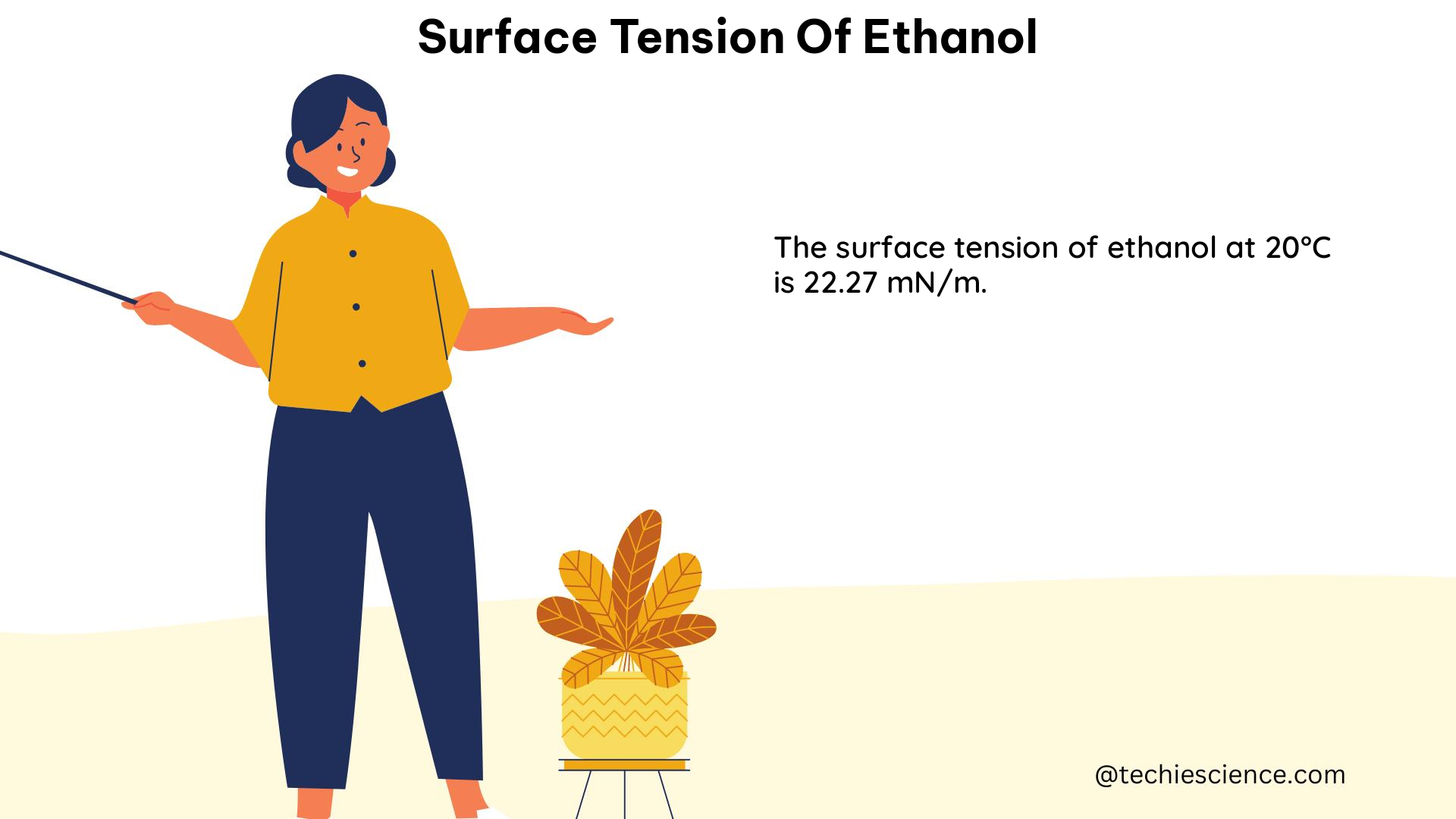The surface tension of ethanol is a crucial property that has been extensively studied and characterized. At 20°C, the surface tension of ethanol is approximately 0.022 N/m, but this value can vary with temperature and concentration. Understanding the surface tension of ethanol is essential in various applications, from chemical engineering to material science.
Understanding Surface Tension
Surface tension is a measure of the cohesive force between the molecules at the surface of a liquid. It arises due to the imbalance of intermolecular forces at the interface between the liquid and the surrounding environment, typically air. The surface tension of a liquid can be expressed using the following equation:
$\gamma = \frac{F}{L}$
Where:
– $\gamma$ is the surface tension (N/m)
– $F$ is the force acting on the surface (N)
– $L$ is the length of the surface (m)
The surface tension of a liquid is influenced by various factors, including temperature, pressure, and the presence of solutes or impurities.
Factors Affecting the Surface Tension of Ethanol

Temperature
The surface tension of ethanol decreases as the temperature increases. This relationship can be described by the following equation:
$\gamma = \gamma_0 – \beta(T – T_0)$
Where:
– $\gamma$ is the surface tension at temperature $T$ (N/m)
– $\gamma_0$ is the surface tension at reference temperature $T_0$ (N/m)
– $\beta$ is the temperature coefficient of surface tension (N/m·°C)
Figure 1 shows the variation of the surface tension of alcohol (c_LV) with the logarithm (base 10) of the alcohol molar fraction in the bulk phase (x_BA) for different temperatures.
Concentration
The surface tension of ethanol-water mixtures also varies with the concentration of ethanol. An empirical equation has been developed to describe this relationship:
$\gamma = \gamma_w – ({\gamma_w – \gamma_e})x_e$
Where:
– $\gamma$ is the surface tension of the ethanol-water mixture (N/m)
– $\gamma_w$ is the surface tension of pure water (N/m)
– $\gamma_e$ is the surface tension of pure ethanol (N/m)
– $x_e$ is the mole fraction of ethanol in the mixture
Pressure
The surface tension of ethanol can also be affected by pressure, particularly in high-pressure environments. A study on the interfacial tension of ethanol, water, and their mixtures in high-pressure CO2 found that the surface tension decreased with increasing pressure.
Measuring the Surface Tension of Ethanol
Several methods are available for measuring the surface tension of ethanol, including the Du Nouy method, the Wilhelmy plate method, and the pendant drop method. The Du Nouy method is a widely used technique that involves measuring the force required to detach a metal ring from the surface of the liquid.
The surface tension can be calculated using the following equation:
$\gamma = \frac{F}{4\pi r}$
Where:
– $\gamma$ is the surface tension (N/m)
– $F$ is the maximum force required to detach the ring (N)
– $r$ is the radius of the ring (m)
The Du Nouy method is particularly useful for determining the surface tension of binary ethanol-water mixtures, as demonstrated in a practical study.
Applications of Surface Tension in Ethanol-Based Systems
The surface tension of ethanol plays a crucial role in various applications, including:
- Chemical Engineering: Surface tension affects the behavior of ethanol-based solutions in processes such as distillation, extraction, and adsorption.
- Material Science: The surface tension of ethanol influences the wetting and spreading behavior of ethanol-based coatings and adhesives.
- Biofuels: The surface tension of ethanol-based biofuels can impact the atomization and combustion characteristics in engine systems.
- Pharmaceuticals: The surface tension of ethanol-water mixtures is important in the formulation of pharmaceutical products, such as topical solutions and suspensions.
- Environmental Applications: The surface tension of ethanol-water mixtures is relevant in the remediation of soil and groundwater contaminated with ethanol-based fuels.
Conclusion
The surface tension of ethanol is a fundamental property that has been extensively studied and characterized. Understanding the factors that influence the surface tension of ethanol, such as temperature, concentration, and pressure, is crucial for various applications in chemical engineering, material science, biofuels, pharmaceuticals, and environmental remediation. The ability to accurately measure and predict the surface tension of ethanol-based systems is essential for optimizing processes and improving the performance of ethanol-based products and technologies.
References
- Insights into the estimation of surface tensions of mixtures based on designable green materials using an ensemble learning. (2023). Retrieved from https://www.ncbi.nlm.nih.gov/pmc/articles/PMC10465615/
- Surface Properties of the Ethanol/Water Mixture. (n.d.). Retrieved from https://espace.curtin.edu.au/bitstream/handle/20.500.11937/79506/79606.pdf?sequence=3
- Interfacial tension of ethanol, water, and their mixtures in high pressure CO2. (2022). Retrieved from https://www.sciencedirect.com/science/article/am/pii/S0021979722000698
- Determination of the Surface Tension of Hydroethanolic Mixtures by the Du Nouy Method. (n.d.). Retrieved from https://www.uv.es/qflab/2021_22/descargas/cuadernillos/qf2/ingles/REV%20P4_Ingles-NEW.pdf
- A plot of the surface tension of alcohol (c_LV) versus logarithm (base 10) of alcohol molar faction in the bulk phase (x_BA) (curves 1–3). (n.d.). Retrieved from https://www.researchgate.net/figure/A-plot-of-the-surface-tension-of-alcohol-c-LV-versus-logarithm-base-10-of-alcohol_fig1_233931725

The lambdageeks.com Core SME Team is a group of experienced subject matter experts from diverse scientific and technical fields including Physics, Chemistry, Technology,Electronics & Electrical Engineering, Automotive, Mechanical Engineering. Our team collaborates to create high-quality, well-researched articles on a wide range of science and technology topics for the lambdageeks.com website.
All Our Senior SME are having more than 7 Years of experience in the respective fields . They are either Working Industry Professionals or assocaited With different Universities. Refer Our Authors Page to get to know About our Core SMEs.